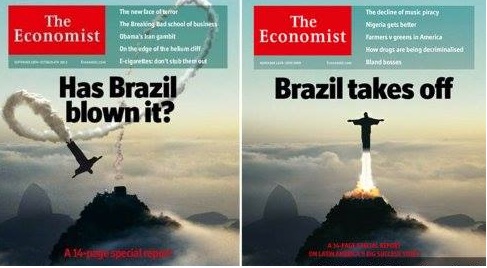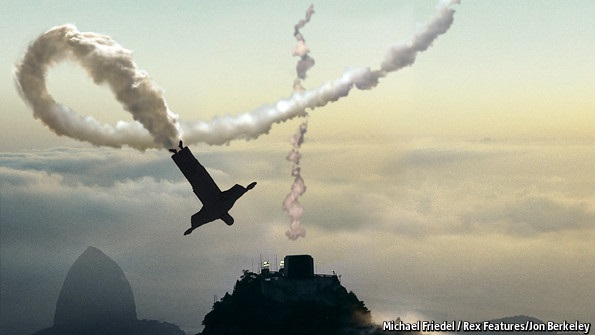 É surpreendente como uma gestão incompetente e visando somente o projeto de poder pelo poder pode destruir um país! Os governos FHC e Lula tiveram os seus méritos, isso é inegável… O primeiro trazendo a estabilidade que o Brasil precisava e o segundo aliando a valorização (aumento da auto estima) do Brasil no mundo com a distribuição de renda… Mas, tudo foi ‘desvirtuado’ e o projeto de um país forte e respeitado mundo afora, que só se consegue com muito trabalho, competência, planejamento, eficiência… foi trocado por um desejo doentio de ‘eternização’ no poder (semelhante aos nossos vizinhos Cuba e Venezuela – que está faltando até papel higiênico!). Vale de tudo: criação de quase 40 ministérios, mais de 23 mil cargos comissionados, fisiologismo, politização de cargos estratégicos (incluindo aí as agências reguladoras), corrupção endêmica, anúncios quase que semanais de programas tidos como milagrosos (e inócuos), contaminação das mais altas esferas (vide algumas indicações para o STF)…
É surpreendente como uma gestão incompetente e visando somente o projeto de poder pelo poder pode destruir um país! Os governos FHC e Lula tiveram os seus méritos, isso é inegável… O primeiro trazendo a estabilidade que o Brasil precisava e o segundo aliando a valorização (aumento da auto estima) do Brasil no mundo com a distribuição de renda… Mas, tudo foi ‘desvirtuado’ e o projeto de um país forte e respeitado mundo afora, que só se consegue com muito trabalho, competência, planejamento, eficiência… foi trocado por um desejo doentio de ‘eternização’ no poder (semelhante aos nossos vizinhos Cuba e Venezuela – que está faltando até papel higiênico!). Vale de tudo: criação de quase 40 ministérios, mais de 23 mil cargos comissionados, fisiologismo, politização de cargos estratégicos (incluindo aí as agências reguladoras), corrupção endêmica, anúncios quase que semanais de programas tidos como milagrosos (e inócuos), contaminação das mais altas esferas (vide algumas indicações para o STF)…
Não tenho nada contra a Sra. Presidenta, possui uma história de luta e vitórias, entretanto, quando assumiu a chefia do Brasil, optou por ser conduzida e não conduzir! Sou favorável a uma mudança na próxima eleição… O grupo atual deve passar um tempo na oposição, acho que já está desgastado (e acomodado)… Seja quem for, Aécio, Marina, Eduardo Campos… Certamente fará um bem gigantesco para o país!
Abaixo consta uma interessante e surpreendente matéria publicada na revista americana ‘The Economist’ que retrata um pouco do que está se passando no nosso país! Triste!
 Has Brazil blown it?
Has Brazil blown it?
A stagnant economy, a bloated state and mass protests mean Dilma Rousseff must change course.
FOUR years ago this newspaper put on its cover a picture of the statue of Christ the Redeemer ascending like a rocket from Rio de Janeiro’s Corcovado mountain, under the rubric “Brazil takes off”. The economy, having stabilised under Fernando Henrique Cardoso in the mid-1990s, accelerated under Luiz Inácio Lula da Silva in the early 2000s. It barely stumbled after the Lehman collapse in 2008 and in 2010 grew by 7.5%, its strongest performance in a quarter-century. To add to the magic, Brazil was awarded both next year’s football World Cup and the summer 2016 Olympics. On the strength of all that, Lula persuaded voters in the same year to choose as president his technocratic protégée, Dilma Rousseff.
Since then the country has come back down to earth with a bump. In 2012 the economy grew by 0.9%. Hundreds of thousands took to the streets in June in the biggest protests for a generation, complaining of high living costs, poor public services and the greed and corruption of politicians. Many have now lost faith in the idea that their country was headed for orbit and diagnosed just another voo de galinha (chicken flight), as they dubbed previous short-lived economic spurts.
There are excuses for the deceleration. All emerging economies have slowed. Some of the impulses behind Brazil’s previous boom—the pay-off from ending runaway inflation and opening up to trade, commodity price rises, big increases in credit and consumption—have played themselves out. And many of Lula’s policies, notably the Bolsa Família that helped lift 25m people out of poverty, were admirable.
The world’s most burdensome tax code
But Brazil has done far too little to reform its government in the boom years. It is not alone in this: India had a similar chance, and missed it. But Brazil’s public sector imposes a particularly heavy burden on its private sector, as our special report explains. Companies face the world’s most burdensome tax code, payroll taxes add 58% to salaries and the government has got its spending priorities upside down.
Compare pensions and infrastructure. The former are absurdly generous. The average Brazilian can look forward to a pension of 70% of final pay at 54. Despite being a young country, Brazil spends as big a share of national income on pensions as southern Europe, where the proportion of old people is three times as big. By contrast, despite the country’s continental dimensions and lousy transport links, its spending on infrastructure is as skimpy as a string bikini. It spends just 1.5% of GDP on infrastructure, compared with a global average of 3.8%, even though its stock of infrastructure is valued at just 16% of GDP, compared with 71% in other big economies. Rotten infrastructure loads unnecessary costs on businesses. In Mato Grosso a soyabean farmer spends 25% of the value of his product getting it to a port; the proportion in Iowa is 9%.
These problems have accumulated over generations. But Ms Rousseff has been unwilling or unable to tackle them, and has created new problems by interfering far more than the pragmatic Lula. She has scared investors away from infrastructure projects and undermined Brazil’s hard-won reputation for macroeconomic rectitude by publicly chivvying the Central Bank chief into slashing interest rates. As a result, rates are now having to rise more than they otherwise might to curb persistent inflation. Rather than admit to missing its fiscal targets, the government has resorted to creative accounting. Gross public debt has climbed to 60-70% of GDP, depending on the definition—and the markets do not trust Ms Rousseff.
Fortunately, Brazil has great strengths. Thanks to its efficient and entrepreneurial farmers, it is the world’s third-biggest food exporter. Even if the government has made the process slower and costlier than it needed to be, Brazil will be a big oil exporter by 2020. It has several manufacturing jewels, and is developing a world-class research base in biotechnology, genetic sciences and deep-sea oil and gas technology. The consumer brands that have grown along with the country’s expanding middle class are ready to go abroad. Despite the recent protests, it does not have the social or ethnic divisions that blight other emerging economies, such as India or Turkey.
An own goal for Dilma Fernández?
But if Brazil is to recover its vim, it needs to rediscover an appetite for reform. With taxes already taking 36% of GDP—the biggest proportion in the emerging world alongside Cristina Fernández’s chaotic Argentina—the government cannot look to taxpayers for the extra money it must spend on health care, schools and transport to satisfy the protesters. Instead, it needs to reshape public spending, especially pensions.
Second, it must make Brazilian business more competitive and encourage it to invest. The way to do that is not, as the government believes, to protect firms, but to expose them to more foreign competition while moving far more swiftly to eliminate the self-inflicted obstacles they face at home. Brazil’s import tariffs remain high and its customs procedures are a catalogue of bloody-minded obstructionism. More dynamic Latin American economies have forged networks of bilateral trade deals. Brazil has hidden behind Mercosur, a regional block that has dwindled into a leftist talking-shop, and the moribund Doha round of world-trade talks. It needs to open up.
Third, Brazil urgently needs political reform. The proliferation of parties, whose only interest is pork and patronage, builds in huge waste at every level of government. One result is a cabinet with 39 ministries. On paper, the solution is easy: a threshold for seats in Congress and other changes to make legislators more accountable to voters. But getting those who benefit from the current system to agree to change it requires more political skill than Ms Rousseff has shown.
In a year’s time Ms Rousseff faces an election in which she will seek a second four-year term. On her record so far, Brazil’s voters have little reason to give her one. But she has time to make a start on the reforms needed, by trimming red tape, merging ministries and curbing public spending. Brazil is not doomed to flop: if Ms Rousseff puts her hand on the throttle there is still a chance that it could take off again.

